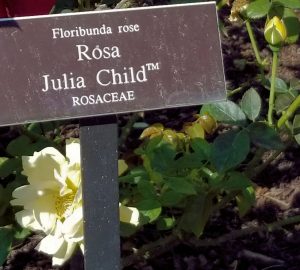Rose hybrid brands demonstrate how branding something turns a commodity into a valuable asset. I took a beautiful fall Friday afternoon off work to visit the New York Botanical Garden, thinking I was playing hooky on my branding business and enjoying the company of some members of my grandmother’s garden club. Yet walking through the Peggy Rockefeller Rose Garden, I found brand after brand after brand among the 650 varieties there.
Rose hybrid brands, it turns out, power a multi-billion dollar industry. From a wildflower growing around the world, hybridizers and growers have created thousands of brands. The U.S. Patent Office lists over 6,000 rose patents, with exponentially more trademarks for rose brand names. Over 60,000 varieties have been created since 1900, with about 3,000 brands currently actively marketed. Brands like Knockout™, Peace™ and Mister Lincoln™ are worth millions of dollars.
 Branding roses isn’t straightforward. The International Code of Nomenclature for Cultivated Plants established 65 years ago tried to establish the principle of one plant, one name. What has happened is that roses get a cultivar name, such as “WEKvossuntono” and then a variety of “marketing names.” WEKvossuntono isn’t much of a brand for a pretty flower. This the buttery yellow rose known as Julia Child™ in the United States is marketed as Absolutely Fabulous™ (after the popular television show) in the United Kingdom and as Soul Mate in Australia™.
Branding roses isn’t straightforward. The International Code of Nomenclature for Cultivated Plants established 65 years ago tried to establish the principle of one plant, one name. What has happened is that roses get a cultivar name, such as “WEKvossuntono” and then a variety of “marketing names.” WEKvossuntono isn’t much of a brand for a pretty flower. This the buttery yellow rose known as Julia Child™ in the United States is marketed as Absolutely Fabulous™ (after the popular television show) in the United Kingdom and as Soul Mate in Australia™.
Rose hybridizers sometimes seek brand names that connote a product features, such as Thrive!™, Drift™, or Garden Delight™. Roses commemorate events like the Miracle on the Hudson™ and favorite songs like Purple Rain™. Others convey a sense of the hybridizer’s whimsy, such as Gourmet Popcorn™, Happy Butt™, or Crush on You™. Many others are named after people—you can buy a Rosie O’Donnell™ rose and plant it next to a Trump Card™ rose. There are no roses named after Hillary Clinton, Nancy Pelosi, John McCain or Mitch McConnell—but never say never. The Joseph Stalin Rose has long been off the market. Consumer brands have jumped in. You can buy a rose called Weight Watchers Success™ and another called Benson & Hedges™ (I wonder if it is fragrant). Perhaps the best, truly honest rose hybrid brand is Ch-Ching™.
There is big money in roses. Will Radler, a rose hobbyist, hybridized Knockout™ in the basement of his suburban Milwaukee home. The first year of its introduction, he received a $60,000 royalty check. Since then, the hybrid became a top seller with over 90 million plants sold. Mr. Radler is a millionaire many times over.
Valuable brands attract counterfeiters like roses attract bees. Some of the biggest brands have banded together to fund the Plant Watch® nursery inspection program. Inspectors visit nurseries to stamp out unauthorized propagation and to ensure compliance with patent and branding requirements.
For rose hybridizers, getting one of your rose hybrid brands planted in the New York Botanical Garden is like getting a painting in the Louvre. Yet among the best sellers and flashy varieties in that garden, you can still find antique heirloom blooms and even wild roses. It is a complete rose education in just over an acre. Walking the fragrant paths of a world class rose garden on an Indian summer morning wasn’t skipping out on work; it was brand research.
